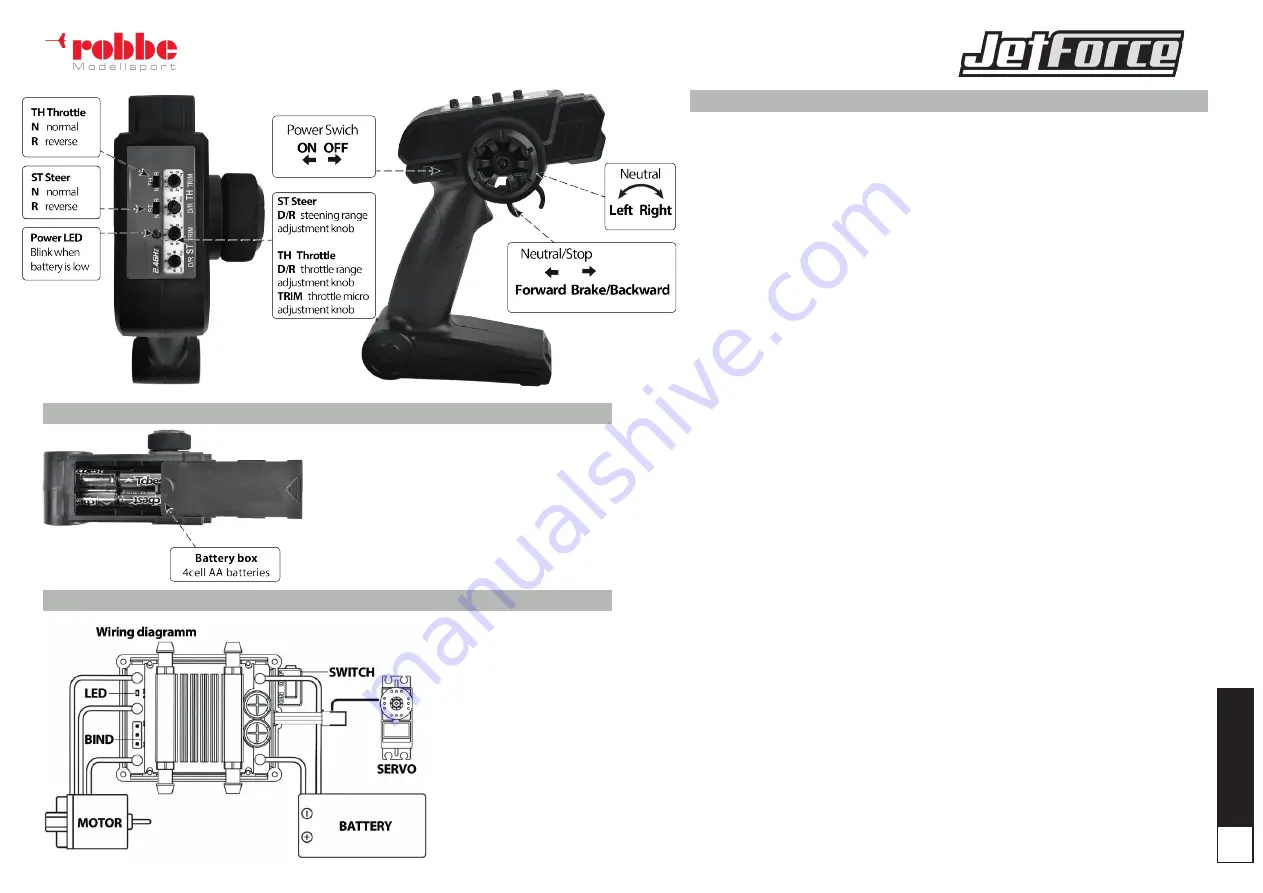
ENGLISH
5
Instructions and User Manual
Warning: The battery is suitable for 4 alkaline batteries, en-
suring that the positive and negative batteries are installed
correctly. Incorrect battery polarity can cause damage to
the remote control! The transmitter comes with a low vol-
tage alarm. When the voltage is lower than 4.6V, the LED
light flashes. Please replace the battery in time!
Receiver interface definition
ON/OFF:
Power switch interface for control-
ling the receiver to turn off;
+/-:
Battery interface for ESC connection to
the power supply battery, supply voltage
range 5-12.6V;
A/B/C:
The receiver has a built-in non-
inductive and brushless electronic governor
output interface, which is used to drive the
brushless motor with a maximum current
of 60A;
ST:
Used for steering servo signal output,
providing servo power and PWM signal
Parameter setting
•
type of battery: Lithium battery (LiPo)
•
Operating mode: two-way without brake (F/R)
•
Notes: F=Forward, R=Reverse
Receiver LED indicator status determination
After the remote control is powered on, the LED light is always on, indicating that the transmitter and
receiver are connected properly and can work normally.
After the receiver is turned on, the LED lights up for 1 second and then goes out.
The receiver does not receive the transmitter signal:
1. The transmitter is not turned on;
2. The remote controller has no frequency; After the receiver is turned on, the LED flashes once per
second, indicating that the battery voltage is low and enters the power limit protection state. In the
frequency mode, the LED light will keep flashing fast until the LED is always on after the frequency is
successful.
Lithium battery series
When the battery type is set to lithium battery, the number of series connection of the lithium battery
will be automatically recognized at power-on, and the “drop” sound will be used for prompting. The
number of “drop” sounds indicates the number of series lithium battery.
Out of control protection
The receiver has built-in out-of-control protection. When the receiver and transmitter are out of contact,
the ESC will stop output and the steering channel output will remain in the final state.
Installation and use points
This remote control is a 2.4G wireless product, so good installation and use have a great impact on
product performance.
Due to the weak penetration of 2.4G signals, in order to ensure reliable communication, it is necessary
to ensure that the transmitter and receiver are used without occlusion.
The remote control receiver has a built-in 2.4G signal receiving module, so it is far away from other elec-
tronic products, motors, etc. when installing, to reduce mutual interference between devices.
The remote transmitter has a built-in antenna, and the antenna is vertically mounted, and the remote
controller is held in a vertical position during use.
The remote control receiver has an antenna. During the installation process, the antenna should be kept
perpendicular to the ground, and there should be no metal or other objects around the antenna.
Due to the influence of external environment, the performance of RF products varies greatly. The above
installation and use points are to ensure the effective and reliable transmission of rf signals of the remo-
te control. Good installation and use is necessary to ensure that the product performance.
Low voltage protection
The receiver has built-in low voltage protection. When it is detected that the battery voltage is below
the protection threshold, it enters a low voltage protection state. When the voltage is lower than a sin-
gle 3.3V (lipo mode), the ESC output power is reduced to a maximum of 50%. When the voltage is lower
than the single-section 3V (lipo mode), the second-level protection will turn off the ESC output.
T R A N S M I T T E R
R E C E I V E R
R E C E I V E R






























